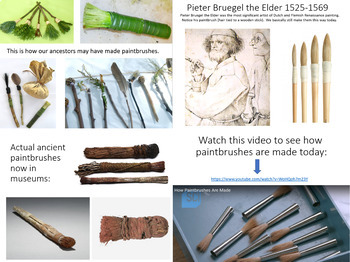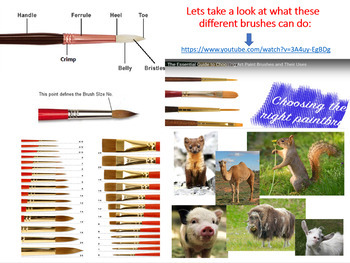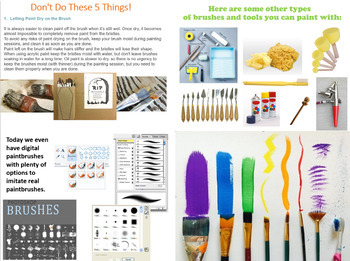Paintbrushes!
- PPTX
Description
Most art teachers teach painting at some point, and what is one of our biggest complaints? The students don’t care about the brushes. They’re not sure how to properly use them, what the different brushes do, what do those numbers on the handles mean, how to hold them, clean them and properly store them. I’ve taught painting to 5 years-old’s all the way through advanced painters in high school and beyond, and I wish I had constructed this PowerPoint years ago do deal with the misuse, mishandling, constant questions, and waste I’ve experienced over the years. This PowerPoint contains 63 image -packed and informative slides which will instill a respect in your students for the simple yet mighty paintbrush. This presentation is so packed with info that it can easily be simplified and shortened for younger grades with shorter attention spans.
The Presentation begins with a handful of slides that show how paintbrushes have evolved over the centuries and also how they’ve stayed the same. Cave paintings are shown which lead to great discussions for why our ancestors felt the need to paint in the first place. There is a link to a short video that shows how paintbrushes are made today. The attention and care involved in making each paintbrush by hand is not only captivating but also instills an admiration for the makers as well as the final product.
Next, we learn about the different types of brushes available, beginning with the brushes natural and synthetic hairs. Why choose synthetic over natural hairs? Why would an artist prefer a sables’ hair over an ox, pig or goat? All of your questions are answered. The presentation then transitions into the different types or shapes of paintbrushes available. Eight common paintbrushes are closely examined for their differences and their attributes. A video link solidifies this information and their unique mark-making abilities are shown and discussed. Naming the parts of the brush, what the numbers mean and how they are determined is shown as well as what an artist looks for when buying a paintbrush.
Next up is a whole section dedicated to the do’s and don’t of paintbrush maintenance. For example: don’t let paint dry on the brush and don’t let them soak for too long. Learning how to properly wash a brush, how to store them and more are discussed along side images that make clear the consequences of not caring for them. Long discussions and hands-on demonstrations (by you the teacher) in class, help to maximize understanding and minimize paintbrush misuse.
The next grouping of slides deals with painting beyond the basic brushes presented so far. Make-up brushes, Sumi-e brushes, house painting brushes, stenciling, sponges and sponge-brushes, toothbrushes, airbrushes, digital brushes, spray-paint, palette knives and more are shown so that connections to our world are explored. There is a newfound appreciation for career possibilities and other painting disciples aside from the merely artistic.
The remainder of the presentation is a hodgepodge of concepts which includes concepts such as: what to do with old and splayed paintbrushes, how different artists hold brushes differently, how artists with special needs might work with paintbrushes, how artists from Frida Kahlo and Chuck Close, to Pieter Bruegel and Henri Matisse hold their brushes, and how using a mahl stick can steady the painters' hand.
Finally, the presentation introduces the day’s (or next day’s) assignment: The students are encouraged to put into practice all that they’ve learned. What is the purpose of each brush? What can I do with it? What types of lines and shapes do they make? Why would I choose one brush over another? The students are asked to try to fill an entire sketchbook page (or loose paper) with unique marks made by your various paintbrushes. They will take notes and write down any surprises or unusual findings. They should label which brush made which marks. Examples of the assignment are shown, and of course the students must show you that they can responsibly clean and store the brushes all by themselves afterward.
If your tired of trying to teach paintbrush brush basics, but always seem to forget a few key concepts, they’re all found here. If you want to instill a mutual respect for your paintbrushes from this point moving forward, this presentation is what you’re looking for. If you want to see your brushes last for years, save your art budget for other artistic pursuits, and have less stress next time you decide it’s time to paint, then you need this presentation. I trust that you and your students will both appreciate and benefit from this presentation and I hope it will become a staple of your teaching for years as it has in my own classroom. Enjoy!
-Bo (The Art Guru)





